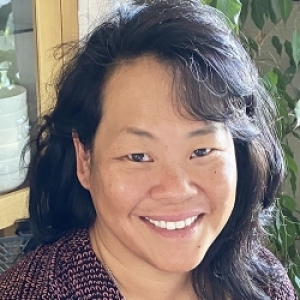Diana S Chu

Diana S Chu
(
She/Her/Hers
)
Professor
Biology, College of Science and Engineering
Bio:
BS in Biochemistry from the University of Californa at Berkeley
PhD in Molecular Biology from the University of California, Los Angeles
Post-doctoral Research in Genetics and Cell Biology at the University of California at Berkeley
Dr. Chu's research is focused on understanding mechanisms that package DNA during sperm formation that contribute to fertility. The Chu Lab uses the model organism C. elegans, which allows us to use approaches in biochemistry, cell biology, molecular biology, and genetics.
Website:
Research
We use the model organism C. elegans to understand how chromosome architecture and dynamics influence gene expression and male fertility.
Epigenetic Paternal Information
Histones are proteins that package DNA. We've identified a histone H2A variant in C. elegans we have named HTAS-1. Our initial analysis has revealed that HTAS-1 is a sperm-specific histone H2A variant. We are using genetic analysis to determine if worms with a mutant htas-1gene are infertile. We've shown that HTAS-1 is indeed required for optimal fertility and are now currently investigating the role of HTAS-1 in chromosome compaction by fluorescence microscopy.
Because histone H2A variants in other organisms are important for gene expression, we are also determining if HTAS-1 is important for regulating gene expression during sperm formation. Initial DNA microarray data has indeed identified many genes whose expression is changed in the htas-1 mutant. We are now investigating the role of HTAS-1 in regulating these genes.
In addition, because HTAS-1 protein differs from canonical H2A proteins in the sequence of the N-terminal tail region (which is known to be post-translationally modified), we are characterizing post-translational modifications that occur on this sperm-specific histone H2A variant.
Partitioning chromosomes during sperm formation
Chromosome segregation during sperm meiosis differs from that of oocyte meiosis and mitosis. We are interesting in defining how these differences are implemented.
We have identified a set of phosphatase proteins we call GSP-3 and GSP-4 that play roles in sperm chromosome segregation. We are characterizing the role of GSP-3 and GSP-4 using genetic mutant analysis and immunostaining. In order to differentiate how the sperm-specific phosphatases (GSP-3 and GSP-4) differ in function from phosphatases found in oocyte meiosis and mitosis (GSP-1 and GSP-2), and characterizing how GSP-1 and GSP-2 function in sperm meiosis. We are also initiating efforts to look for proteins that interact directly with GSP-3 and GSP-4 by coimmunprecipitation.
Publications
Samson M, Jow MM, Wong CL, Fitzpatrick C, Aslanian A, Saucedo I, Estrada R, Ito T, Park S R, Yates JR and Chu DS
The specification and global reprogramming of histone epigenetic marks during gamete formation and early embryo development in C. elegans
Accepted to PLoS Genetics
Chu DS and Shakes DC
Adv Exp Med Biol. 2013;757:171-203. doi: 10.1007/978-1-4614-4015-4_7. Review.
Wu JC, Go AC, Samson M, Cintra T, Mirsoian S, Wu TF, Jow MM, Routman EJ, Chu DS
Sperm development and motility are regulated by PP1 phosphatases in Caenorhabditis elegans.
GENETICS 2012 Jan;190(1):143-57. Epub 2011 Oct 31.
Wu TF, Nera B, Chu DS and Shakes DC
Systems Biology in Reproductive Medicine 2010 Jun;56(3):222-35.
Han T, Manorhan AP, Harkins TT, Bouffard P, Fitzpatrick C, Chu DS, Theirry-Mieg D, Thierry-Mieg J, and Kim JK
Germline-generated 26G endo-siRNAs regulate spermatogenic and zygotic gene expression in C. elegans
Proceedings of the National Academy of Sciences 2009 Nov 3;106(44):18674-9.
Shakes DC, Wu J, Sadler PL, LaPrade K, Moore LL, Noritake A and Chu DS
Spermatogenesis-specific features of the meiotic program in Caenorhabditis elegans
PLoS Genetics 2009 Aug;5(8):e1000611. Epub 2009 Aug 21.
Wu, TF and Chu DS
Sperm chromatin: fertile grounds for proteomic discovery of clinical tools.
Mol Cell Proteomics 2008 Oct 7 (10):1876-86.
Wu, TF and Chu DS
Reproductive BioMedicine Online 2008 Jan;16 (1):13-22.
Chu DS, Liu H, Nix P, Wu TF, Ralston EJ, Yates JR, and Meyer BJ
Sperm chromatin proteomics identifies evolutionarily conserved fertility factors.
Nature 2006 Sep 7, 443 (7107):101-5